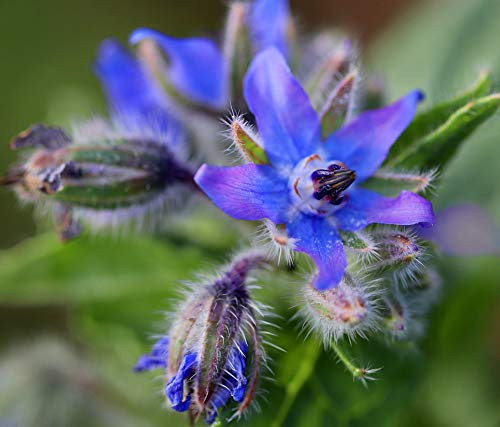Borage is an easy, fast-growing annual herb with vivid blue flowers and the flavor and scent of cucumbers. While it is considered an herb, it's often grown as a flower in vegetable gardens where it attracts pollinating bees and is considered a good companion plant for tomatoes, squash, and strawberries. Its even supposed to deter tomato hornworms and improve the flavor of tomatoes growing nearby.
Native to the Mediterranean, Borage is a somewhat gangly plant, but you barely notice it because the star-shaped flowers are so vibrant. It also boasts a greenish-grey stem and leaves that are covered in a prickly fuzz.
After planting your borage in early spring, its blooms will emerge in June and July, hanging in downward facing clusters. Both the flowers and the leaves of the plant are edible, with a unique flavor similar to a cucumber. Use the leaves while they are young because as the plant matures, the stalks and leaves become covered with a prickly fuzz.
Borage Care
It's rare that you find an herb that is as beautiful as it is delicious, but borage does the trick. Commonly planted in vegetable or herb gardens, it acts as a magnet for bees and other pollinators while adding a charming, cottage-style appeal with its petite blue buds. Caring for borage is rather simple, as the herb doesn't require any special treatment. Its ability to thrive in even the driest soils or drought-like weather has earned it an easy-to-care-for reputation.
When first introducing borage to your garden, plant the seeds in early spring after the final frost has passed. Borage can bloom from late spring through summer and will reach maturity in about eight weeks, at which point you can harvest the leaves and flowers as need. Keep in mind, the plants will start to decline if they are not deadheaded and are left to go to seed. Staggering your planting times will give you a longer period of bloom and provide a longer harvest time. If the flowers fade before you
Borage Seed to Plant - 200 Seeds Non-GMO Heirloom Seeds Easy Planting and Growing a Kitchen Herb Garden
Was:
$45.70
Now:
$22.85
- SKU:
- ZA76651
- UPC:
- 755331720782
- Condition:
- New
- Availability:
- Free Shipping from the USA. Estimated 2-4 days delivery.







